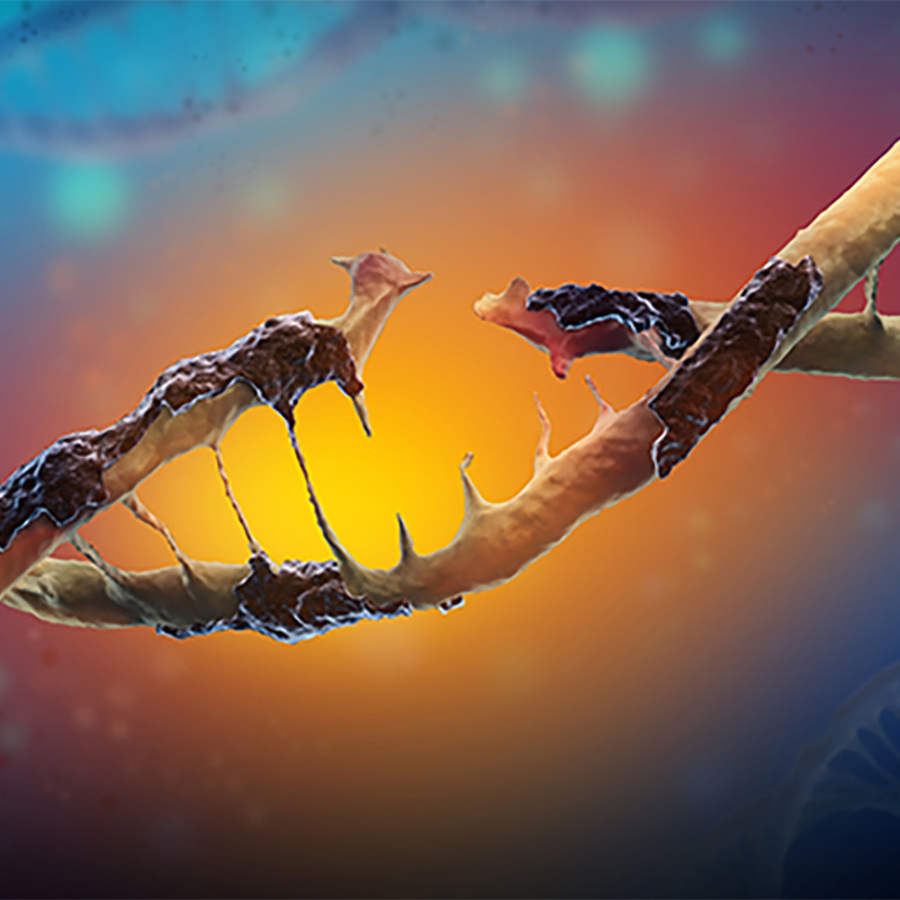
Could a mutation cause a child to have an unexpected blood type?
July 14, 2006

- Related Topics:
- Blood type,
- Mutation,
- Rare events,
- ABO blood type,
- Recombination
A curious adult from Oregon asks:
“Is it possible, through mutation, for two blood type O (OO) parents to have a non type O child? Along the same lines, it is possible for mutation to account for any blood type in a child or are there limitations on which mutations are possible?”
Theoretically yes, but it would be extremely rare. Two O parents will get an O child nearly all of the time.
But as with anything in biology, there are occasional exceptions to this rule. New mutations -- or changes in the DNA -- are theoretically one way these kinds of uncommon scenarios can happen.
Keep in mind, though, that mutations are very rare. And the odds of having a mutation in precisely the right spot to change your blood type … even more unlikely.
But it is technically possible for two O-type parents to have a child with A or B blood, and maybe even AB (although this is even more unlikely).
In fact, a child can get almost any kind of blood type if you consider the rule-breaking exceptions. For example, chimerism and Bombay blood group could both explain two O parents having a non-O child. (Cis-AB blood type is another way to break the rules, but it won’t explain this scenario.)
While these other exceptions are rare, they’re a bit more likely to happen than mutation. But since you asked specifically about mutations, that’s what I’m going to focus on for the rest of this article.
New blood types evolved from new mutations
First off, the genetic differences between you and me are very small. We inherit the vast majority of these differences from our parents.
But DNA can change when cells copy their DNA. This copying process is incredibly accurate but doesn't work perfectly. By the time we are born, we have on average 100 or so new mutations.
This may sound like a lot of mutations. But remember that you have 6 billion letters of DNA. The chance of a mutation happening in a specific spot in your DNA is around 2x10-8 … literally a 1 in 50 million chance!
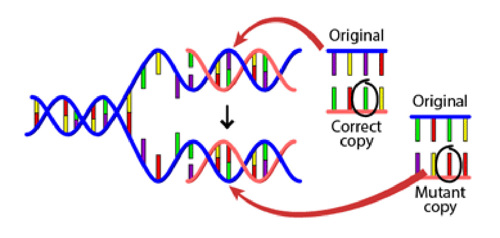
Our own DNA changes a bit during our lifetimes too. These changes come about because we are alive. Turning our food into energy can mutate our DNA. As can the sunlight that hits us or chemicals in the air we breathe. All of these can lead to random new mutations.
The differences between A, B, and O blood types are actually very small. And all of these differences originally came from mutations!
What changes are we talking about? To understand this, we need to go into a little bit of detail about DNA.
Remember, DNA is made up of four different kinds of chemicals called bases. Each gene is a code, or recipe, for how to make a protein.
The ABO blood type is determined by a single gene that comes in three versions A, B, and O. The difference between A and O is a single base -- the O type is missing a base. The difference between A and B is seven bases.
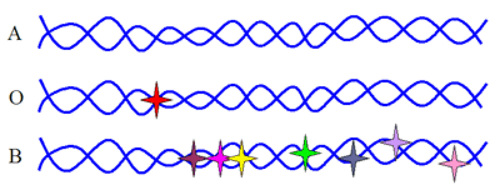
You're probably thinking that one less base or seven different bases shouldn't matter that much. But it can actually make a big difference.
See, the gene is actually a code that is read by the cell three bases at a time. Changing only one base can change the code entirely.
As an example, here's a sentence that uses only three-letter words: "The old man had one new hat."
If you change the last "T" to an "M", the sentence would read: "The old man had one new ham."
Now let's take out the first "E", and move all the other letters up so that each word is still three letters long: "Tho ldm anh ado nen ewh am."
Now the sentence is complete nonsense. Mutations can have the same effect on genes. (For more on this, see the starred section at the end of this article.*)
The O version is most commonly a nonsense version of the A form. At some point in our distant past, someone got a mutation that caused a base to go missing in their A gene. Now that person has the O form. And that person was successful and so the O mutation spread.
Could mutation lead to an A type from an O?
Yes, if a mutation happened in just the right spot. If the cell added a letter back to the O version in the right place, it'd change to A. But remember, I said the odds of changing a specific spot in the DNA are around 1 in 50 million.
But you actually might be able to add back a letter nearby without too much trouble. Sometimes changing one word in a long sentence isn't that big a deal. You can still sort of figure out what is going on.
Let’s go back to a nonsense sentence: "Tho ldm anh ado nen ewh at."
And try adding back in a single random letter (“I”) near the beginning: "Tho ild man had one new hat."
While it’s not identical, it’s pretty similar now to the original sentence: "The old man had one new hat."
Even though it’s a bit different, you can still get the basic gist of what the sentence says. Similarly, adding a single letter back to the O version may be similar enough to look like Type A to a blood type test.
Since there are a few ways to get an “understandable” sentence, the chance of this happening is a bit higher than that 1 in 50 million chance I mentioned earlier.
So this is how an O parent could produce an A child, with a single base change. Again, I want to emphasize that this situation is very rare. But it is theoretically possible.
Could you get B type from an O?
Theoretically, but it’s so unlikely that it’s close to impossible. Remember that the most common O version of the gene looks more like the A gene than the B gene.
There are 7 differences between the O and B versions. And it would be very unlikely to get 7 of the right base changes all at once to go from O to B.
Can you get A type from B type?
Well, yes. But it requires a different kind of mutation.
As we talked about, the odds against changing 7 bases all at once are so high that it is pretty much impossible to change an A to a B that way. However, there is yet another kind of mutation, called recombination, which can make it possible to get A from B.
You can think of recombination as a "cut and paste" of the two different forms of a gene within a single person.
So far we've been thinking about each person as having either A, B or O type genes. But remember that every person actually has two different forms of a gene -- one from each parent. By the way, these different "forms" of a gene are called alleles.
Let's say there's a man named Bob with one B type and one O type allele. With this combination, Bob must have B type blood.
When Bob produces sperm, only one allele is selected to be carried by each sperm cell. Sometimes it's the B allele, and sometimes it's the O allele.
Remember that the most common O alleles look like the A allele except they're missing one base in the middle. If you took the beginning of Bob's B allele and placed it onto the end of his O allele, you would get a new allele that works just like the A type.
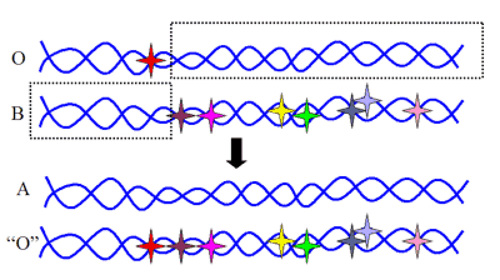
Swapping part of O with part of B can make an A blood type. This is called recombination.
Therefore, if Bob has a child with an O type mother, the child would have A type blood, even though neither parent had an A type allele. If he has a child with a B type mother, the child would be AB.
This sounds strange, and indeed it is a rare event, but it can and does happen. In fact, we know that this specific scenario occurred in one Japanese family back in 1997.
In this case, the mother had B type blood and her child A type. The father, with type O blood, was originally told that he couldn't possibly be the father.
After further protest by the father, scientists looked closer at the DNA of both the father and the child. Looking outside of the ABO gene at markers in other segments of the DNA, they found that indeed the O type man was the father.
They concluded that the child must have inherited an allele that was the result of a recombination in the mother between the B and O alleles.
So, as you can see, mutations can explain some of the rare outcomes that seem to defy the common genetic rules. Though they are very rare, they are a key part to understanding genetic inheritance.
* Your genetic “sentences”
Each group of three DNA bases tells the cell which kind of protein building block to use. There are 20 different kinds of amino acids, the protein building blocks:
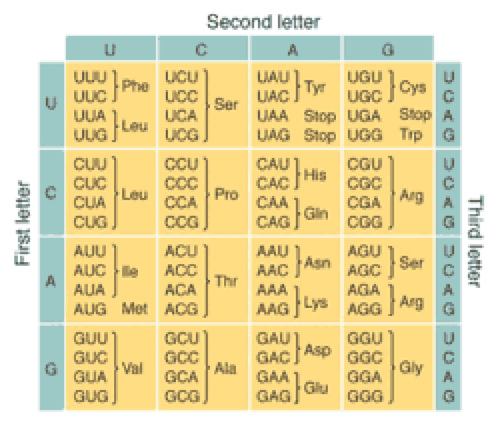
Here's a sequence of DNA bases from the ABO gene:
GTC CTC GTG GTG ACC CCT TGG
If you were a cell, you would know that this DNA sequence makes a protein with the following set of amino acids:
Val Leu Val Val Thr Pro Trp
Now imagine that one of the "G"s in the middle (the red one) is taken out of the DNA sequence. All the bases after it get shifted to the left:
GTC CTC GTG GTA CCC CTT GGC
That changes the protein sequence after the mutation to:
Val Leu Val Val Pro Leu Gly
That's a completely different set of amino acids, and therefore a completely different protein.
Now, what I didn't tell you is that there is a three-letter code that tells the cell when to stop making the protein -- when you've reached the end of the gene.
It turns out that by removing this particular G, the cell finds a stop signal earlier than usual.
This is the exact difference between A type and O type blood. Most people with O type have a single base deletion that causes the cell to stop making the protein too early. Therefore they never make a working enzyme.
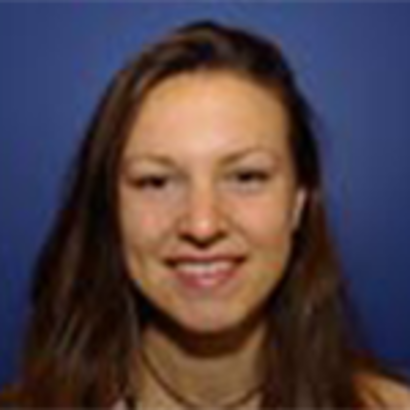
Author: Natalie Dye
When this answer was published in 2006, Natalie was a Ph.D. candidate in the Department of Biochemistry, studying bacterial cytoskeletal proteins in Julie Theriot's laboratory. Natalie wrote this answer while participating in the Stanford at The Tech program.
 Skip Navigation
Skip Navigation
